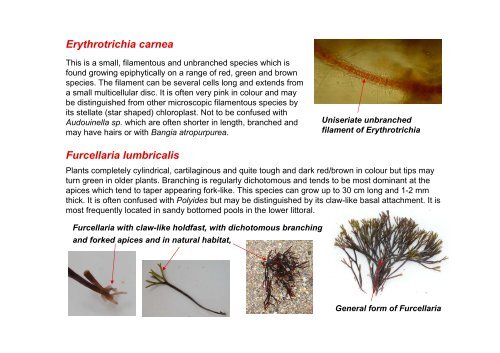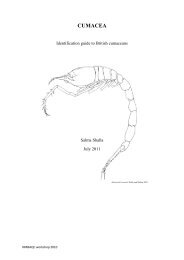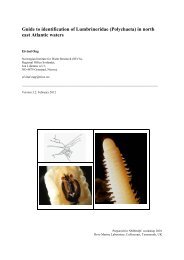s A Field Guide to the British Seaweeds - NMBAQC
s A Field Guide to the British Seaweeds - NMBAQC
s A Field Guide to the British Seaweeds - NMBAQC
You also want an ePaper? Increase the reach of your titles
YUMPU automatically turns print PDFs into web optimized ePapers that Google loves.
Erythrotrichia carnea<br />
This is a small, filamen<strong>to</strong>us and unbranched species which is<br />
found growing epiphytically on a range of red, green and brown<br />
species. The filament can be several cells long and extends from<br />
a small multicellular disc. It is often very pink in colour and may<br />
be distinguished from o<strong>the</strong>r microscopic filamen<strong>to</strong>us species by<br />
its stellate (star shaped) chloroplast. Not <strong>to</strong> be confused with<br />
Audouinella sp. which are often shorter in length, branched and<br />
may have hairs or with Bangia atropurpurea.<br />
Furcellaria lumbricalis<br />
Plants completely cylindrical, cartilaginous and quite <strong>to</strong>ugh and dark red/brown in colour but tips may<br />
turn green in older plants. Branching is regularly dicho<strong>to</strong>mous and tends <strong>to</strong> be most dominant at <strong>the</strong><br />
apices which tend <strong>to</strong> taper appearing fork-like. This species can grow up <strong>to</strong> 30 cm long and 1-2 mm<br />
thick. It is often confused with Polyides but may be distinguished by its claw-like basal attachment. It is<br />
most frequently located in sandy bot<strong>to</strong>med pools in <strong>the</strong> lower lit<strong>to</strong>ral.<br />
Furcellaria with claw-like holdfast, with dicho<strong>to</strong>mous branching<br />
and forked apices and in natural habitat,<br />
Uniseriate unbranched<br />
filament of Erythrotrichia<br />
General form of Furcellaria




